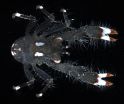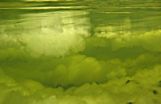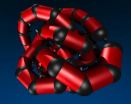(Press-News.org) Experts from the Centre for Advanced Studies of Blanes and the University of Barcelona (UB) collected and studied different crustacean specimens during recent expeditions to Madagascar, New Caledonia, Vanuatu, the Philippines and French Polynesia.
Using morphological and molecular data they have discovered five new species of crustaceans in the waters of these regions. They are genetically different but morphologically very similar and they also found a new genus, named Triodonthea. The five new species documented in the study belong to the Lauriea genus of the Galatheidae family, which is differentiated easily from other species of the group as it has very long setae and their legs end in a double spine.
"The Triodonthea is a new genus that it genetically very different from the Lauriea species despite being very morphologically similar. The morphological differences are small to our eyes but reflect great inequalities on a species level," as explained to SINC by Enrique Macpherson, researcher at the Centre for Advanced Studies of Blanes and co-author of the study along with Aymee Robainas-Barcia from the UB.
The description of any new genus is based on the fact that a certain species possesses characteristics that nearby species do not. The separation and ordering of species into genera and families consists of grouping species according to common characteristics using Linnaean Taxonomy, a modern-day biological classification system.
"These species (both from Lauriea as well as Sadayoshia) can be found in the Indian and Pacific Oceans but not in the American Pacific. They are generally in shallow water and mostly in areas of coral reef. Some are endemic, as they only live on an archipelago or in a very specific area, whereas others spread from Madagascar to the French Polynese," points out Macpherson.
This study forms part of previous work that began more than 20 years ago in 1976 with French and US expeditions across the entire Indian and Pacific Oceans. "We have explored the oceans to a depth of up to 5,000 m," ensures the researcher.
The expeditions collect samples from diving, nets, traps and dredges, etc. Animals are separated on board or in the laboratory and then sent to the experts of each taxonomic group. Macpherson specialises in this group of crustaceans: the squat lobsters.
INFORMATION:
References:
Enrique Macpherson, Aymee Robainas-Barcia.. "A new genus and some new species of the genus Lauriea Baba, 1971 (Crustacea, Decapoda, Galatheidae) from the Pacific and Indian Oceans, using molecular and morphological characters", Zootaxa 3599 (2): 136), 4 de enero 2013.
The discovery of a new genus of crustacean and 5 new species
2013-02-15
ELSE PRESS RELEASES FROM THIS DATE:
Force is the key to granular state-shifting
2013-02-15
Ever wonder why sand can both run through an hourglass like a liquid and be solid enough to support buildings? It's because granular materials – like sand or dirt – can change their behavior, or state. Researchers from North Carolina State University have found that the forces individual grains exert on one another are what most affect that transition.
Physicists have explored the changing behavior of granular materials by comparing it to what happens in thermodynamic systems. In a thermodynamic system, you can change the state of a material – like water – from a liquid ...
Chemists develop single molecule sieves to separate complex molecular mixtures
2013-02-15
Chemists at the University of Liverpool have created a new technique that could be used in industry to separate complex organic chemical mixtures.
Chemical feedstocks containing benzene are used extensively in industry to create modern materials and polymers. Their use relies heavily on distillation techniques which separate complex mixtures into more simple molecules used as building blocks to develop drugs, plastics and new materials. These distillation techniques can be expensive and involve large amounts of energy for hard-to-separate mixtures.
A team of researchers ...
Rutgers physicists test highly flexible organic semiconductors
2013-02-15
Organic semiconductors hold promise for making low-cost flexible electronics – conceivably video displays that bend like book pages or roll and unroll like posters, or wearable circuitry sewn into uniforms or athletic wear. Researchers have demonstrated the ability to "print" transistors made of organic crystals on flexible plastic sheets, using technology that resembles inkjet or gravure printing.
However, for the technology's potential to be realized, scientists have to show that these organic semiconductors will withstand the rugged handling they invite – they will ...
Extreme winters impact fish negatively
2013-02-15
Wcologists from Umeå University and the Norwegian University of Science and Technology in Trondheim have studied fish communities and fish habitat and reviewed the importance of winter conditions for fish in streams and rivers in cold regions. The findings are now being published in the journal BioScience.
It is well known that winter can be a stressful season for plants and animals in streams and rivers. It is reasonable to assume that more extreme weather conditions are the most taxing, but the ecological significance of this is poorly understood.
The research team, ...
UC research takes a new approach to identifying 'food deserts'
2013-02-15
University of Cincinnati-led research takes a new direction in examining the availability of healthy foods for urban populations by examining the commuting patterns of its residents.
This new approach to identifying so-called food deserts, now published online, will appear in the May journal of Health and Place.
Neighborhoods without access to stores that provide healthy food options – such as fresh fruits and vegetables – are often labeled as food deserts. However, current methods for determining which neighborhoods have access to nutritious foods focus only on where ...
Nano-machines for 'bionic proteins'
2013-02-15
This press release is available in German.
Physicists of the University of Vienna together with researchers from the University of Natural Resources and Life Sciences Vienna developed nano-machines which recreate principal activities of proteins. They present the first versatile and modular example of a fully artificial protein-mimetic model system, thanks to the Vienna Scientific Cluster (VSC), a high performance computing infrastructure. These "bionic proteins" could play an important role in innovating pharmaceutical research. The results have now been published in ...
Study finds possible link between diabetes and increased risk of heart attack death
2013-02-15
Having diabetes doubles a person's risk of dying after a heart attack, but the reason for the increased risk is not clear. A new University of Iowa study suggests the link may lie in the over-activation of an important heart enzyme, which leads to death of pacemaker cells in the heart, abnormal heart rhythm, and increased risk of sudden death in diabetic mice following a heart attack.
"Many studies have shown that patients with diabetes are at especially high risk for dying from a myocardial infarction (heart attack). Our study provides new evidence that this excess ...
Wild plants are infected with many viruses and still thrive
2013-02-15
UNIVERSITY PARK, PA. -- Researchers have studied viruses as agents of disease in humans, domestic animals and plants, but a study of plant viruses in the wild may point to a more cooperative, benevolent role of the microbe, according to a Penn State virologist.
"Most of these wild plants have viruses," said Marilyn Roossinck, professor of plant pathology and environmental microbiology and biology, who has examined more than 7,000 individual plants for viruses. "But they don't have any of the symptoms that we usually see in crop plants with viruses."
Most of the viruses ...
Technique that removes additional toxins prolongs dialysis patients' lives
2013-02-15
Highlights
A technique that removes additional toxins during dialysis decreased kidney failure patients' risk of dying from any cause by 30% over three years.
The technique also reduced patients' risk of dying from heart-related causes or infections.
15% to 25% of dialysis patients die annually.
Washington, DC (February 14, 2013) — A technique that removes additional toxins during dialysis may prolong kidney failure patients' lives, according to a clinical trial appearing in an upcoming issue of the Journal of the American Society Nephrology (JASN). In light of ...
Accelerated protons confirm origin of cosmic rays
2013-02-15
We are constantly being bombarded by speedy, energetic, and yet unassuming, particles called cosmic rays. These charged particles (mostly protons), continuously assail the Earth from outer space. There is general consensus among scientists that supernova remnants (the leftovers of a supernova explosion) are the sources of cosmic rays, but the final proof has been elusive since cosmic rays are deflected on their way from the source to Earth.
A new study offers conclusive evidence that cosmic ray protons within our galaxy are accelerated in the shock waves produced by ...


